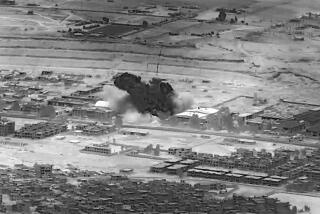Fallouja Fight Among Deadliest in Years for U.S.
- Share via
BAGHDAD — Seventy-one U.S. troops died in the November battle to retake the city of Fallouja, according to the top Marine commander in Iraq, a toll significantly higher than the previous count of 51 deaths.
An additional 623 American troops were wounded, said Marine Lt. Gen. John F. Sattler, up from an injury count of 425 issued more than two weeks ago.
The Fallouja offensive made November one of the two most deadly months for American military personnel since the U.S.-led invasion of Iraq in March 2003.
The U.S. death toll in November was at least 134, according to wire service compilations, nearing the mark of 135 killed in April -- when an aborted offensive in Fallouja also contributed to a sharp increase in dead and injured.
Officials say casualty figures during last month’s fight for Fallouja were among the highest in recent years for any battle involving U.S. troops. But they were still low for the kind of house-to-house urban warfare that took place, they said.
The casualties “were lighter than history would have predicted by a pretty large factor,” said Sattler, who heads the 1st Marine Expeditionary Force. “We were expecting well above that.... It could have been a lot worse.”
More than 60% of the wounded U.S. troops returned to duty within 72 hours, Sattler noted in a telephone interview from the Marine base east of Fallouja.
Proclaiming the success of the operation, Sattler said that at least 1,200 insurgents had been killed. But among those neither captured nor killed were the city’s best-known guerrilla leaders -- Jordanian-born Abu Musab Zarqawi; Omar Hadid, Zarqawi’s Iraqi lieutenant; and Abdullah Janabi, a Sunni Muslim cleric who headed the loosely governing Shura Council during the six months of insurgent control in Fallouja.
“Would it have been nice to have killed or captured any of those three? Absolutely,” Sattler said. “But we’re still terrifically pleased.... Fallouja is no longer a terrorist sanctuary.”
Sattler said many foreigners were probably among the dead, most of whom carried no identification. Of 2,000 suspects detained, 40 non-Iraqis had been identified, he added.
“We think some of the ones who fought to the end could be foreign fighters,” Sattler said.
More than 1,200 of those detained have since been released.
The numbers of U.S. dead and injured in Fallouja are consistent with major combat casualty rates for similar periods of time -- about 10% total casualties and about 1% dead, said Dan Goure, a defense analyst at the Lexington Institute, an Arlington, Va., public policy group.
Precision airstrike and artillery capability allowed U.S. forces to attack many targets from a distance without risking troops on the ground, analysts said. Protective vests, improved helmets and add-on armor for Humvees and other vehicles also helped limit casualty rates, they said.
“We used to think heavy armor was a deathtrap in urban combat. You can’t see ahead. People drop Molotov cocktails on you,” Goure said. “That didn’t happen here.”
Up to 6,000 U.S. military personnel, along with about 2,000 allied Iraqi troops, stormed the mostly Sunni Muslim city about 35 miles west of Baghdad in the offensive that began more than three weeks ago. Another 3,500 U.S. and Iraqi troops maintained a cordon outside the city. Seven Iraqi troops were killed and 43 wounded, Sattler said.
Most of Fallouja’s 300,000 residents fled before the offensive, which resulted in widespread damage to the city. U.S. and Iraqi forces have been clearing rubble, downed power lines, bodies, unexploded ordnance and other remnants of the battle. Authorities will begin allowing civilians to return, on a limited basis, around Dec. 15, Sattler said.
He expressed confidence that Fallouja residents would be able to vote in national elections scheduled for late January. Al Anbar province, where Fallouja is located, is considered the heart of the Sunni-led insurgency and stands as the only major region of Iraq where voter registration has yet to begin.
In an effort to thwart the return of guerrilla fighters to Fallouja, Sattler said, officials plan to maintain checkpoints at major entrances and exits and institute a system of passes and badges for vehicles and people cleared to enter the city.
As the Fallouja operation continued, other U.S.-led attacks occurred in the northern city of Mosul and in the northern part of Babil province, a Sunni insurgent hot spot south of Baghdad.
The Fallouja offensive and U.S.-led attacks north and south of Baghdad have been part of a military policy of attempting to restore some measure of Iraqi government control to insurgent havens before the elections.
“We owe it to those Marines and soldiers who have sacrificed their lives to help ensure ... Iraqi efforts to carry out this political process to the best of our abilities,” John D. Negroponte, the U.S. ambassador to Iraq, told journalists this week.
The most recent Pentagon figures indicate that at least 1,254 U.S. military personnel have died in Iraq since the war began. More than 9,300 have been wounded.
In an interview last week, Army Lt. Gen. David H. Petraeus, the U.S. commander overseeing the training and equipping of Iraqi forces, acknowledged that combat would probably continue for some time.
“Everyone recognizes that it will be a fight to the elections in those provinces where the insurgents are active,” Petraeus said. “There’s still a good deal of fighting left to be done.”
The bloodshed has dashed hopes U.S. casualties would drop once Iraq formally regained its sovereignty in late June. Instead, the number of U.S. troops killed has risen every month since, with the exception of October.
More to Read
Sign up for Essential California
The most important California stories and recommendations in your inbox every morning.
You may occasionally receive promotional content from the Los Angeles Times.










